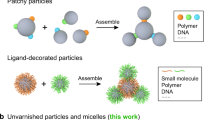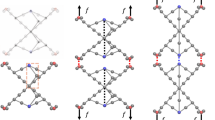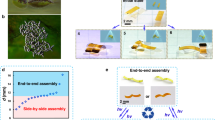Abstract
The fabrication of multifunctional materials with tunable structure and properties requires programmed binding of their building blocks1,2. For example, particles organized in long-ranged structures by external fields3,4 can be bound permanently into stiff chains through electrostatic or van der Waals attraction4,5, or into flexible chains through soft molecular linkers such as surface-grafted DNA or polymers6,7,8,9,10,11. Here, we show that capillarity-mediated binding between magnetic nanoparticles coated with a liquid lipid shell can be used for the assembly of ultraflexible microfilaments and network structures. These filaments can be magnetically regenerated on mechanical damage, owing to the fluidity of the capillary bridges between nanoparticles and their reversible binding on contact. Nanocapillary forces offer opportunities for assembling dynamically reconfigurable multifunctional materials that could find applications as micromanipulators, microbots with ultrasoft joints, or magnetically self-repairing gels.
This is a preview of subscription content, access via your institution
Access options
Subscribe to this journal
Receive 12 print issues and online access
$259.00 per year
only $21.58 per issue
Buy this article
- Purchase on Springer Link
- Instant access to full article PDF
Prices may be subject to local taxes which are calculated during checkout




Similar content being viewed by others
References
Nie, Z., Petukhova, A. & Kumacheva, E. Properties and emerging applications of self-assembled structures made from inorganic nanoparticles. Nature Nanotech. 5, 15–25 (2010).
Velev, O. D. & Gupta, S. Materials fabricated by micro- and nanoparticle assembly—the challenging path from science to engineering. Adv. Mater. 21, 1897–1905 (2009).
Grzelczak, M., Vermant, J., Furst, E. M. & Liz-Marzan, L. M. Directed self-sssembly of nanoparticles. ACS Nano 4, 3591–3605 (2010).
Hermanson, K. D., Lumsdon, S. O., Williams, J. P., Kaler, E. W. & Velev, O. D. Dielectrophoretic assembly of electrically functional microwires from nanoparticle suspensions. Science 294, 1082–1086 (2001).
Bharti, B., Findenegg, G. H. & Velev, O. D. Co-assembly of oppositely charged particles into linear clusters and chains of controllable length. Sci. Rep. 2, 1004 (2012).
Hill, L. J. & Pyun, J. Colloidal polymers via dipolar assembly of magnetic nanoparticle monomers. ACS Appl. Mater. Interfaces 6, 6022–6032 (2014).
Singh, H., Laibinis, P. E. & Hatton, T. A. Synthesis of flexible magnetic nanowires of permanently linked core-shell magnetic beads tethered to a glass surface patterned by microcontact printing. Nano Lett. 5, 2149–2154 (2005).
Li, D., Banon, S. & Biswal, S. L. Bending dynamics of DNA-linked colloidal particle chains. Soft Matter 6, 4197–4204 (2010).
Cohen-Tannoudji, L. et al. Polymer bridging probed by magnetic colloids. Phys. Rev. Lett. 94, 038301 (2005).
Devries, G. a et al. Divalent metal nanoparticles. Science 315, 358–361 (2007).
Leunissen, M. E. et al. Switchable self-protected attractions in DNA-functionalized colloids. Nature Mater. 8, 590–595 (2009).
Hornbaker, D. J., Albert, R., Albert, I., Barabasi, A.-L. & Schiffer, P. What keeps sandcastles standing? Nature 387, 765 (1997).
Butt, H. J. & Kappl, M. Normal capillary forces. Adv. Colloid Interface Sci. 146, 48–60 (2009).
Min, Y., Akbulut, M., Kristiansen, K., Golan, Y. & Israelachvili, J. The role of interparticle and external forces in nanoparticle assembly. Nature Mater. 7, 527–538 (2008).
Koos, E. & Willenbacher, N. Capillary forces in suspension rheology. Science 331, 897–900 (2011).
Bowden, N., Choi, I. S., Grzybowski, B. A., Whitesides, G. M. & Street, O. Mesoscale self-assembly of hexagonal plates using lateral capillary forces: Synthesis using the ‘capillary bond’. J. Am. Chem. Soc. 121, 5373–5391 (1999).
De Volder, M. & Hart, A. J. Engineering hierarchical nanostructures by elastocapillary self-assembly. Angew. Chem. Int. Ed. 52, 2412–2425 (2013).
Doyle, P. S., Bibette, J., Bancaud, A. & Viovy, J.-L. Self-assembled magnetic matrices for DNA separation chips. Science 295, 2237 (2002).
Cho, E. C., Shim, J., Lee, K. E., Kim, J. W. & Han, S. S. Flexible magnetic microtubules structured by lipids and magnetic nanoparticles. ACS Appl. Mater. Interfaces 1, 1159–1162 (2009).
Bannwarth, M. B. et al. Well-defined nanofibers with tunable morphology from spherical colloidal building blocks. Angew. Chem. Int. Ed. 52, 10107–10111 (2013).
Klinkova, A., Thérien-Aubin, H., Choueiri, R. M., Rubinstein, M. & Kumacheva, E. Colloidal analogs of molecular chain stoppers. Proc. Natl Acad. Sci. USA 110, 18775–18779 (2013).
Muxworthy, A. R. & Williams, W. Critical superparamagnetic/single-domain grain sizes in interacting magnetite particles: Implications for magnetosome crystals. J. R. Soc. Interface 6, 1207–1212 (2009).
Pichon, B. P. et al. 2D assembling of magnetic iron oxide nanoparticles promoted by SAMs used as well-addressed surfaces. J. Phys. Chem. C 114, 9041–9048 (2010).
Rawicz, W., Olbrich, K. C., McIntosh, T., Needham, D. & Evans, E. Effect of chain length and unsaturation on elasticity of lipid bilayers. Biophys. J. 79, 328–339 (2000).
Royer, J. R. et al. High-speed tracking of rupture and clustering in freely falling granular streams. Nature 459, 1110–1113 (2009).
Bico, J., Ashmore-Chakrabarty, J., McKinley, G. H. & Stone, H. A. Rolling stones: The motion of a sphere down an inclined plane coated with a thin liquid film. Phys. Fluids 21, 082103 (2009).
Rubinstein, M. & Colby, R. H. Polymer Physics (Oxford Univ. Press, 2003).
Boal, D. Mechanics of the Cell (Cambridge Univ. Press, 2002).
Biswal, S. L. & Gast, A. P. Rotational dynamics of semiflexible paramagnetic particle chains. Phys. Rev. E 69, 041406 (2004).
Ghosh, B. & Urban, M. W. Self-repairing oxetane-substituted chitosan polyurethane networks. Science 323, 1458–1460 (2009).
Acknowledgements
The authors gratefully acknowledge support from the US National Science Foundation (NSF) Triangle MRSEC on Programmable Soft Matter (DMR-1121107) and the US Army Research Office (ARO) (W911NF-15-1-0115). M.R. acknowledges financial support from the NSF under grants DMR-1122483, DMR-1309892 and DMR-1436201, from the National Institutes of Health (NIH) under grants P01-HL108808 and 1UH2HL123645, and from the Cystic Fibrosis Foundation. A.L.F. thanks BIA-INRA Nantes for her new faculty fellowship. We gratefully acknowledge C. Gaillard for the cryo-TEM experiments done at the BIBS Plate-forme INRA Nantes, France. We acknowledge the experimental assistance of B. Houinsou-Houssou, N. Galinsky, J. Zhao and J. C. Ledford. We are also grateful to L. Reynolds, J. Tracy and G. H. Findenegg for discussions on the data and their interpretation.
Author information
Authors and Affiliations
Contributions
B.B., A.-L.F. and O.D.V. conceived and designed the experiments. B.B. and A.-L.F. performed the experiments. M.R. proposed the persistence-length analysis and interpretation of filament flexibility. B.B. performed the experimental data analysis. B.B. and O.D.V. wrote the manuscript. All authors read and commented on it.
Corresponding author
Ethics declarations
Competing interests
The authors declare no competing financial interests.
Supplementary information
Supplementary Information
Supplementary Information (PDF 1950 kb)
Supplementary Information
Supplementary Movie 1 (MP4 1856 kb)
Supplementary Information
Supplementary Movie 2 (MP4 2333 kb)
Supplementary Information
Supplementary Movie 3 (MP4 781 kb)
Supplementary Information
Supplementary Movie 4 (MP4 7944 kb)
Supplementary Information
Supplementary Movie 5 (MP4 5698 kb)
Rights and permissions
About this article
Cite this article
Bharti, B., Fameau, AL., Rubinstein, M. et al. Nanocapillarity-mediated magnetic assembly of nanoparticles into ultraflexible filaments and reconfigurable networks. Nature Mater 14, 1104–1109 (2015). https://doi.org/10.1038/nmat4364
Received:
Accepted:
Published:
Issue Date:
DOI: https://doi.org/10.1038/nmat4364
This article is cited by
-
Dual nature of magnetic nanoparticle dispersions enables control over short-range attraction and long-range repulsion interactions
Communications Chemistry (2022)
-
Low-dimensional assemblies of metal-organic framework particles and mutually coordinated anisotropy
Nature Communications (2022)
-
Programmed magnetic manipulation of vesicles into spatially coded prototissue architectures arrays
Nature Communications (2020)
-
Polymers with controlled assembly and rigidity made with click-functional peptide bundles
Nature (2019)
-
Magnetically tunable bidirectional locomotion of a self-assembled nanorod-sphere propeller
Nature Communications (2018)



